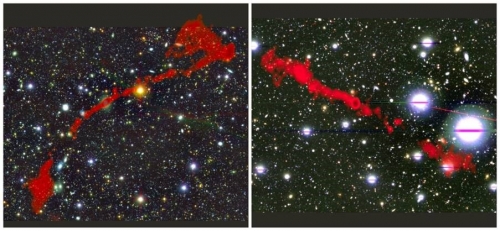Two giant radio galaxies have been discovered using South Africa’s powerful MeerKAT telescope. These galaxies are very rare and amongst the largest single objects in the universe, according to the University of Cape Town’s Faculty of Science.
The South African MeerKAT radio telescope is a radio telescope situated in the Northern Cape. It was launched in 2018 and is one of four precursors to the final Square Kilometre Array (SKA) Radio Telescope.
MeerKAT detected the two new galaxies in a relatively small patch of sky and findings in the online journal Monthly Notices of the Royal Astronomical Society suggest that these radio galaxies could be more common than previously thought.
“The MeerKAT telescope is the best of its kind in the world. We have managed to identify these giant radio galaxies for the first time because of MeerKAT’s unprecedented sensitivity to faint and diffuse radio light. This made it possible to detect features that haven’t been seen before,” said Dr Ian Heywood, a co-author at the University of Oxford
These findings provide further clues on how galaxies have changed and evolved.
UCT’s Faculty of Science explains that many galaxies have supermassive black holes, and when large amounts of interstellar gas orbit and fall in towards the black hole, it activates the black hole and causes it to release energy.
The charged particles of these active galaxies often interact with strong magnetic fields near the black hole, which causes huge beams of radio light or ‘jets’ to be emitted. These jets can sometimes be bigger than the galaxy itself and reach much further into intergalactic space.
“Many hundreds of thousands of radio galaxies have already been discovered. However, only around 800 of these have radio jets exceeding 700 kilo-parsecs in size or around 22 times the size of the Milky Way. These truly enormous systems are called ‘giant radio galaxies'” explains Dr Jacinta Delhaize, a Research Fellow at the University of Cape Town (UCT) and lead author of the work.
“We found these giant radio galaxies in a region of sky which is only about four times the area of the full moon. Based on our current knowledge of the density of giant radio galaxies in the sky, the probability of finding two of them in this region is extremely small. This means that giant radio galaxies are probably far more common than we thought!”
Dr Matthew Prescott, a Research Fellow at the University of the Western Cape and co-author of the work added: “These two galaxies are special because they are much bigger than most other radio galaxies. They are more than 2 Mega-parsecs across which is around 6.5 million light-years or about 62 times the size of the Milky Way. Yet they are fainter than others of the same size. We suspect that many more galaxies like these should exist, because of the way we think galaxies should grow and change over their lifetimes.”
Picture: UCT

